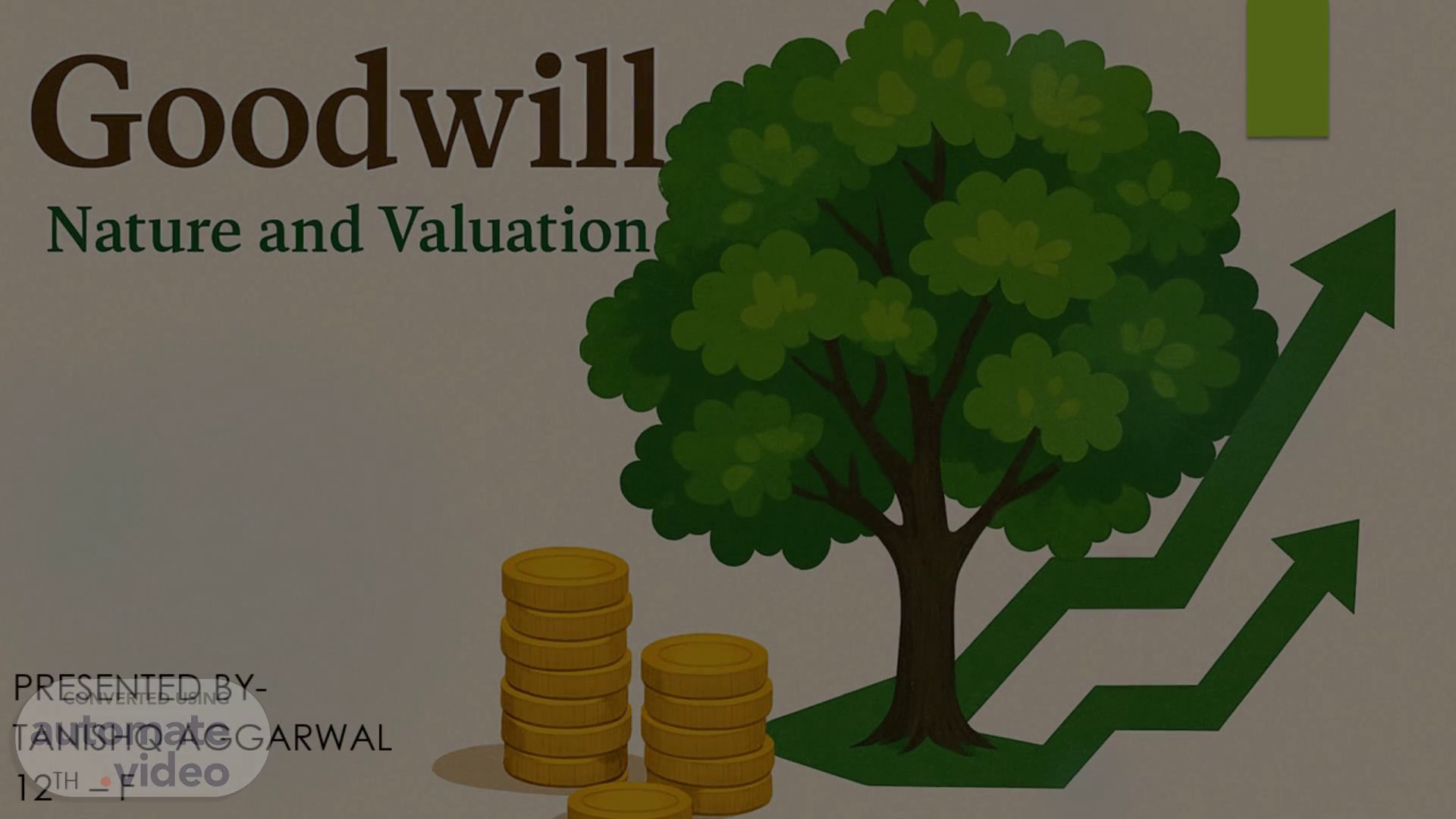Scene 1 (0s)
PRESENTED BY- TANISHQ AGGARWAL 12TH – F.
Scene 2 (7s)
CONTENT. MEANING OF GOODWILL CHARACTERISTICS OR FEATURES OF GOODWILL NEED FOR VALUING GOODWILL FACTORS AFFECTING THE VALUE OF GOODWILL METHODS OF VALUATION OF GOODWILL CONCEPT OF NUMBER OF YEAR’S PURCHASED.
Scene 3 (20s)
MEANING OF GOODWILL. “Goodwill is an intangible assets which places an enterprise at an advantage because of which the enterprise earns higher profits than normal.”.
Scene 4 (31s)
CHARACTERISTICS OR FEATURES OF GOODWILL. It is an intangible assets and not a fictitious assets. It does not have an existence separate from that of an enterprise. Thus, normally it has realizable value when business or a part of business is sold. It helps in earning higher profits. It attracts customers to come frequently. It comes into existence due to various factors such as locational advantages, favourable contracts, brands, trademarks, patents, market reputation, etc. Value of goodwill is subjective as it depends on the assessment of the valuer..
Scene 5 (57s)
NEED FOR VALUING GOODWILL. The need for valuation of goodwill arises: When there is change in the profit-sharing ratio. When a new partner is admitted. When a partner retires or dies. When partner firm is sold as going concern When two or more firms amalgamate. When a partnership is converted into a company..
Scene 6 (1m 15s)
FACTORS AFFECTING THE VALUE OF GOODWILL. Goodwill is affected by the factors which increase the earning capacity of the firm. Some of these are: Efficient Management: If the management is experienced, capable and competent, the firm will earn higher profits as compared to other firms. Favourable Location: If the business is located at a favourable place, resulting in increased customer walk-in and, therefore, increased sala and increased profit. Favourable Contracts: Sometimes, a firm has long-term contracts for sale and purchase of goods at favourable prices. This will also affect profits and goodwill of the firm. Market Situation: If a firm is in a business wherein demand for the products dealt in is higher than the supply, it will lead to lower capital requirement and higher profit. It will, thus, increase the value of it’s goodwill. Quality: If a firm enjoys good reputation for the quality of it’s products, there will be a ready sake and the value of it’s goodwill, therefore, will be high..
Scene 7 (1m 58s)
Methods of Valuation of Goodwill There are various Methods of Valuation of Goodwill of any business based on its market value or previous years profit/losses. These are explained as follows: - Average Profit II. Super Profit Capitalisation of Profit utor's Simple Average Profit Weighted Average Profit Capitalisation of the Average Profit Capitalisation of the Super Profit.
Scene 8 (2m 14s)
AVERAGE PROFIT METHOD. WEIGHTED AVERAGE PROFIT METHOD.
Scene 9 (2m 24s)
NOTE:. Before calculating the average profits the following adjustments should be made in the profits of the firm: Any abnormal profits should be deducted from the net profits of that year. Any abnormal losses should be added back to the net profits of that year. Non-operating incomes e.g. income from investments etc. should be deducted from the net profits of that year.
Scene 10 (2m 45s)
SIMPLE AVERAGE PROFIT METHOD. STEP1: CALCULATION OF AVERAGE PROFIT: AVERAGE PROFITS= TOTAL OF GIVEN YEAR PROFIT/ NO. OF YEAR STEP2: CALCULATION OF GOODWILL: VALUE OF GOODWILL= AVERAGE PROFITS * NUMBER OF YEAR’S PURCHASED.
Scene 11 (2m 59s)
WEIGHTED AVERAGE PROFIT METHOD. STEP 1: CALCULATION OF WEIGHTED AVERAGE PROFIT: WEIGHTED AVERAGE PROFIT= TOTAL OF WEIGHTED PROFIT/ TOTAL OF WEIGHTS STEP 2: CALCULATION OF GOODWILL: VALUE OF GOODWILL=WEIGHTED AVERAGE PROFIT * NUMBER OF YEAR’S PURCHASED.
Scene 12 (3m 13s)
WHAT IS NUMBER OF YEAR’S PURCHASED??. “Number of year’s purchased” means the number of years for which the firm is likely to earn similar profit after change in ownership because of the efforts put in the past..
Scene 13 (3m 27s)
[image] A chart of a super profit method.
Scene 14 (3m 35s)
A close-up of a diagram.
Scene 15 (3m 42s)
A close-up of some notes.
Scene 16 (3m 50s)
CAPITALISATION OF PROFIT METHOD. CAPITALISATION OF AVERAGE PROFIT.
Scene 17 (3m 59s)
CAPITALISATION OF SUPER PROFIT. STEP 1 TO STEP 4 WILL REMAINS SAME AS DISCUSSED IN SUPER PROFIT METHOD… STEP 1: CALCULATION OF CAPITAL EMPLOYED: CAPITAL EMPLOYED= TOTAL ASSETS – EXTERNAL LIABILITIES STEP 2: NORMAL PROFIT= CAPITAL EMPLOYED * RATE OF RETURN/100 STEP 3: CALCULATION OF ACTUAL AVERAGE PROFIT STEP 4: SUPER PROFIT= ACTUAL AVERAGE PROFIT – NORMAL PROFIT STEP 5: CALCULATION OF GOODWILL BY CAPITALISATION OF SUPER PROFIT: GOODWILL= SUPER PROFIT * 100/ NORMAL RATE OF RETURN.
Scene 18 (4m 22s)
CAPITALISATION OF AVERAGE PROFIT. STEP 1: CALCULATION OF AVERAGE NORMAL PROFITS: AVERAGE PROFITS= TOTAL OF GIVEN YEAR PROFIT/ NO. OF YEAR STEP 2: CALCULATION OF CAPITALISED VALUE OF THE FIRM: CAPITALISED VALUE= ACTUAL AVERAGE PROFIT * 100/ RATE OF RETURN STEP 3: CALCULATION OF VALUE OF NET ASSETS: NET ASSETS= ALL ASSETS OTHER THAT GOODWILL, NON-TRADE INVESTMENT, FICTITIOUS ASSETS –EXTERNAL LIABILITY STEP 4: CALCULATION OF GOODWILL BY CAPITALISATION OF AVERAGE PROFIT: GOODWILL= CAPITALISED VALUE OF FIRM – NET ASSETS.
Scene 19 (4m 47s)
THANKS FOR WATCHING.
